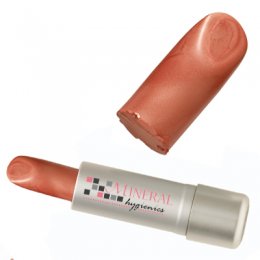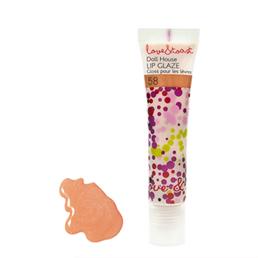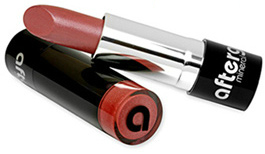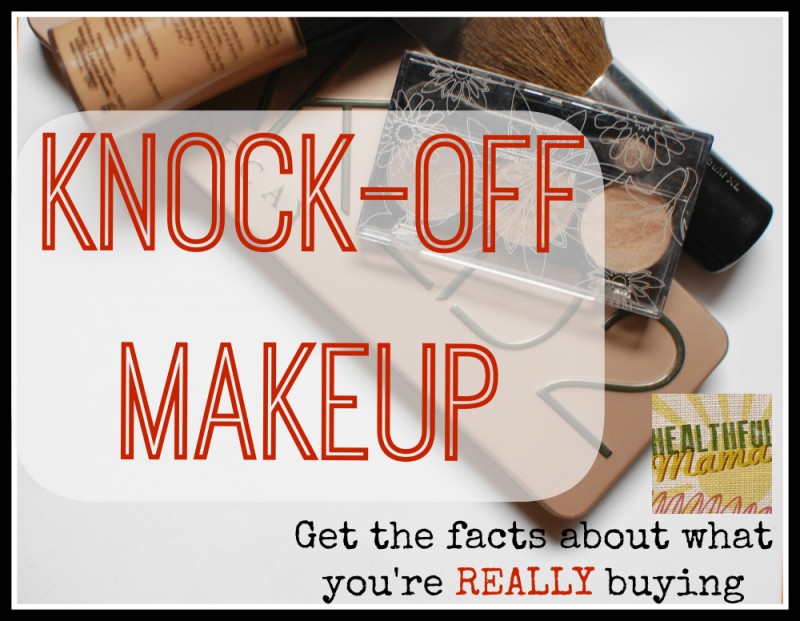
[pinit]
Although the fact that some lipsticks contain lead isn’t new news, this fact has been circulating mainstream media recently. I’m happy that toxins in cosmetics are getting more exposure, because until the Safe Cosmetics Act is put fully into place, there are no regulations for the products which we put on our hair and skin.
The following lead-free lipstick manufacturers not only make products that are free of toxic chemicals, but limit their ingredients so you KNOW what you’re putting on your face. Just because a brand markets itself as “natural” doesn’t mean it’s safe.
The only questionable ingredient found in all of these lipsticks is titanium dioxide. However, according to Environmental Working Group (EWG), titanium dioxide “appears to have low skin penetration but inhalation is a concern.” So, it’s most likely safe in your lipstick, but you don’t want it in, say, your spray-on sunscreen.
Many of the lipsticks listed here can be found online at Pharmaca, a natural-health-focused pharmacy that is found only in the Western U.S. I shop at Pharmaca regularly, and love that their products are available online as well.
Afterglow Cosmetics– Lip Love Lipstick ($24)
Afterglow lipsticks are unlike other mineral lipsticks I’ve tried. Afterglow could be considered a luxury brand, comparable to department store cosmetics. The lipstick goes on smoothly and lasts long. Bonus: Afterglow Cosmetics are certified organic, cruelty-free, and gluten-free!

Mineral Hygienics–Mineral Pure Lips ($12)
All of Mineral Hygienics products have simple, safe ingredients (I use their mineral foundation daily). The only downfall is that Mineral Pure Lips is available in only a few colors.
 <
<
Nvey Eco Cosmetics Lipstick ($29)
Safflower Oil, Organic Castor Oil and Vitamin E provide antioxidant and nourishing properties to this creamy lipstick. Nvey Eco labels its product GMO-free! Nvey Eco is available most affordably through Vine.com. Get it for even less! Take 20% off your first order at Vine by using code HEALTHFUL.
ZuZu Luxe Lipstick ($17.99)
ZuZu Luxe is a division of Gabriel Cosmetics. As far as I can tell, the ingredients in the lipsticks are virtually the same. ZuZu Luxe is a bit easier to find (and often discounted), in my experience. I love using the ZuZu Luxe Oil-Free Liquid Foundation in the winter, or under my mineral foundation if I want more coverage. I’m a big fan of the quality and wearability of the ZuZu Luxe line of products.

Need a gloss? Try Love & Toast Dollhouse Lip Glaze ($6.99)
Simple ingredients like sunflower seed oil, olive oil, and vitamin E make this a gloss you can trust to be safe AND gorgeous.
Do you have a favorite beauty product that you’d like to detoxify? Let me know in the comments!
Affiliate links appear in this post. The few cents I may make from your purchase help to fund this blog–I thank you! photo credit: cobalt123 via photopin cc





I’m a lipstick addict so thank you for introducing me to a few new brands. I’ll have to check some of them out.
I am a presenter with younique. Younique started in November 2012 so not known as well as others. We just now added a lipstick line. If you should want more information email me. I am learning so many things that I was unaware of and I have changed 7 brands in our home so far. Unreal companies owned by the same can branch off and lie. Let alone sell products that contain chemicals that kill us.
I am a presenter with younique. Younique started in November 2012 so not known as well as others. We just now added a lipstick line. If you should want more information email me. I am learning so many things that I was unaware of and I have changed 7 brands in our home so far. Unreal companies owned by the same can branch off and lie. Let alone sell products that contain chemicals that kill us. Elmore_trish@yahoo.com
healthfulmama??? Why not healthymama?
I’ve just had a look at these lipsticks and unfortunately have seen none of these brands in Spain. I just don’t know what to buy.
https://www.dr.hauschka.com/en_DE/products/lipstick/
These are from Germany. You can probably get Dr. Hauschka in Spain.
ZuZu may go on smoothly, but it doesn’t stay on at all. Very disappointing.
What do you define as “stay on,” Marsha? Unfortunately, most non-toxic lipsticks don’t have a ton of staying power when compared to traditional brands. I even got a sample of organic lip STAIN that doesn’t last as long as traditional lipstick. I just reapply more often 🙂
Hi, I just wanted to recommend an amazing brand I’ve round that ship internationally- cherry brown. As natural as it gets and brilliant colours and stays on amazingly. Also feels like nothing on my lips!
Titanium dioxide is a carcinogen. Studies have shown that nanoscale/ fine grains of titanium dioxide are cancer causing and it affects humans on a cellular level. There are many debates on this mineral that is old as earth itself. World Health organization (WHO) concluded that it is not harmful to human males after studies (nanoparticles were not considered), however it could cause lung fibrosis. As a scientist and a female, the studies are not good enough to put this product in make up that female’s use and absorbed by the body everyday. On average 7 pounds of lipsticks are eaten/ absorbed by a woman in her lifetime. Canada has also classified titanium dioxide as a carcinogen,s o why are we still using it in make up and toothpaste. My advice is to pay particular attention to the ingredients of the makeup, ingredients such as alcohol and titanium dioxide, nanoparticles of any kind, and lead should be avoided. SO if you are trying to keep healthy, try green people, natural solutions, rejuvenate minerals etc. or make ur own.
Hey naz, thanks for the info and suggested products. Do you have any links or titles of these studies? I keep reading conflicting opinions concerning titanium dioxide and nano particles.
we should not use titanium dioxide: (this answers all your questions)
Why?, because not only is Titanium Dioxide known to damage cells & speed up the ageing process of our skin, it is now being investigated as a potential carcinogen.
It has long been known that Titanium Dioxide is not photo stable, when it is exposed to light on your skin it creates free radicals that in-turn attack your skin cells causing premature ageing. As if that isn’t bad enough, now it is being linked to cancer.
Have a look in your bathroom cupboard, not only are you eating Titanium Dioxide on a daily basis but you are also smothering your largest breathing organ (your skin) with it every single day. Nearly all cosmetics (even supposedly natural ones) contain large amounts of Titanium Dioxide, you will find it in your powders, foundations, lipsticks, eyeshadows, blushes & even in your sunscreen (although it may not be listed in the ingredients – legally they don’t have to list everything, only “active” ingredients).
Not a nice thought when it has been proven that substances applied to the skin show up in the blood stream within half an hour.
So go through your bathroom cupboards & ditch the Titanium Dioxide today, not only will you prevent premature ageing of your skin, but you might just save your life.
Check out our Titanium Dioxide FREE BB cream, makeup & Sunscreens for the whole family.
The U.S. food industry is notorious for poisoning the very consumers who drive their multi-billion dollar enterprise, even spending millions against their right to informed consent (truthful GMO labeling). So, is it any wonder that this deregulated and increasingly deranged juggernaut is experimenting on its own customer base by exposing them to trillions of toxic nanoparticles?
A new study published in Biomedicine and Pharmacotherapy titled, “Effects of titanium dioxide nanoparticles in human gastric epithelial cells in vitro,” reveals for the first time that the nanoparticle form of the common “whitening” agent known as titanium dioxide is capable of inducing “tumor-like” changes in exposed human cells.[1]
Whereas previous cell research has established that titanium dioxide (TiO2) is cytotoxic (cell damaging),[2] this is the first study of its kind to find exposed cells undergo a ‘phenotypal’ transition from normal to cancerous cell traits, including an increased rate of cell proliferation and a decrease in programmed cell death – hallmark features of precancerous and/or cancerous cells associated with ‘immortalization.’
Owing to the fact that the researchers tested human gastric epithelial cells, a type of stomach cell in direct contact with material we eat, and considering the broad range of drug, personal care and food products nanoparticle TiO2 is commonly used within, the toxicological implications of these findings are deeply concerning.
We Are Already Eating Titanium Dioxide
TiO2 is a naturally occurring oxide of titanium, and has a wide range of industrial applications as a “whitening” pigment in plastics, ceramic glazes and paints. It is used in sunscreens as a UV absorbing “sun protection factor,” due to its high refractive index. Most of our risk of exposure comes from its use in toothpaste, drugs and excipient-heavy supplements as a pill coating, and food products, including even milk (to ‘improve’ appearance and texture).
Indeed, given that TiO2 is found in thousands of consumer products, the odds are that you are already being exposed to a significant quantity of them on a daily basis. As reported byEverydayhealth.com, “You ingest around 100 trillion nanoparticles every day, researchers at Binghamton University and Cornell University say.”
So, what are some common brands who use it? Nanotitanium is found in products produced by Jello, Nestlé, M&M’s, Mother’s, Mentos, Albertson’s, Hostess and Kool Aid.
Below is a table from the 2012 E Magazine article “Eating Nano” revealing its presence in common U.S. packaged goods.
Is Titanium Dioxide Regulated?
Much like present day radiobiological risk assessments for technologies like mammography were developed long before the discovery of DNA, making it impossible to comprehend their DNA-damaging properties at that time, present day biosafety regulations of TiO2 were determined long before the advent of nanotechnology. In both cases, the true harms of these technologies were — and still are — greatly underestimated.
As a result of this information gap, TiO2 is currently classified as ‘generally recognized as safe’ (GRAS) by the FDA, regardless of format. Remarkably, the FDA still allows titanium dioxide in sunscreens “at concentrations of up to 25 percent alone and 2 to 25 percent in combination with any proposed Category I sunscreen active ingredient” without considering the toxicity differential of particle size.[3] Considering that concentrations as low as 0.001% by weight have been found to exhibit clear cytotoxicity within exposed cells,[4] the biosafety regulations governing TiO2 are as great as 5 orders of magnitude or higher less stringent than they should be to protect the consumer.
Nanoparticles are so small they are below the threshold of visibility. This is one reason why they are used for sun protection factor, as 100 nanometers or smaller particles will not leave the white pasty appearance on the skin associated with larger particles. What you can’t see, however, is still there – and in the case of nanotitanium, may slip through the surface layers of our skin into more sensitive tissues, as well as our blood stream. This is also why, if you use sunscreen, you should make sure the ingredients say “non-nanoparticle” when describing titanium dioxide or zinc oxide. And this rule applies to purportedly ‘natural’ brands as well.
Technically, a nanoparticle, also known as a ‘ultrafine particle,’ is a particle that is sized within the nanometer scale: literally, anywhere between 1-100 billionth (nano) of a meter in diameter. Going up in scale, larger particles are known as ‘fine particles,’ sized between 2,500 and 100 nanometers, and so-called ‘coarse particles’ are sized between 10,000 and 2,500 nanometers.
How ‘Smaller’ Can Indicate A Much Larger Problem
Nanotechnology inverts the unsophisticated logic of conventional toxicology risk assessments: namely, that the smaller the amount of something (concentration or size), the less harmful it is. We have seen how this logic has failed with petrochemical-derived chemicals like benzene, considered toxic in the parts-per-trillion range, and endocrine disrupters like bisphenol A and parabens, which exert powerful hormone-mimicking properties that sometimes increase as their concentration decrease. More recently, Monsanto’s Roundup herbicide (glyphosate), was found to exhibit estrogenicity (and concomitant carcinogenicity) in the parts-per-trillion concentration range. There is also the case of so-called ‘low dose’ radioisotopes such as depleted uranium, whose relatively low radiolytic decay relative to gamma-ray emitting plutonium generates the illusion that it is safer (recent research performed by the U.S. Army’s own Radiobiological Research Institute indicates these “lower risk” radiation sources cause up to a million-fold more damage than present risk models explain due to a phenomenon known as the photoelectic effect).
In other words, less is not only more, but when it comes to particle size, smaller sizes often convey exponentially higher toxicity than larger ones.
Why Are We Not Being Protected?
So, why isn’t more being done to protect the consumer from the clear and present health threat represented by nanotechnology? Considering that the Food and Drug Administration does exactly that: administers and/or executes the interests of the food and drug manufacturers, we are supplicating to the wrong entity. The FDA is at least consistent by deciding to allow the food industry to govern itself, but what about the food industry’s liability in saturating our food supply with trillions of nanoparticles per serving, without warning the consumer?
According to Tom Philpot, writing for Grist in 2010, “As with GMOs, the strategy seems to be: release into the food supply en masse first; assess risks later (if ever).”
This strategy, while a seemingly successful short-term business model for nanotechnology stakeholders, is utter insanity when one considers the long-term fall out it will have on the industry once millions wake up to the fact they have been treated, once gain, like guinea pigs.
Moreover, as a growing body of peer-reviewed research on the dangers of nanoparticles accumulates, the millions who have already been exposed unknowingly to their ill effects have a legal right to sue for damages. The food industry’s increasingly nefarious stance towards the very consumers who ensure their continued business defies logic, and indicates just how unethical their business model really is.
There is really only one answer to this problem. As with unlabeled GMOs, the consumer must refuse to consume them, forcing the manufacturers to bow to the holy dollar and reformulate; or, better yet, the ‘consumer’ must learn how to redefine itself entirely by becoming, once again, a producer, one garden (urban, suburban or rural) at a time. By growing and eating whole foods directly from the earth, we eliminate a wide range of health hazards the mass market food industry has built into their disease-promoting business model.
Article Resources
[1] Monica Catarina Botelho, Carla Costa, Susana Silva, Solange Costa, Alok Dhawan, Paula A Oliveira, João P Teixeira. Effects of titanium dioxide nanoparticles in human gastric epithelial cells in vitro. Biomed Pharmacother. 2013 Aug 23. Epub 2013 Aug 23. PMID: 24051123
[2] GreenMedInfo.com, Research > Problem Substances > Index: T’s > Titanium Dioxide
[3] FDA. Sunscreen Drug Products for Over-the-Counter Human Use; Amendment to the Tentative Final Monograph; Enforcement Policy. Federal Register. 1998;63:56584–56589.
[4] Julia X Yu, Thomas H Li. Distinct biological effects of different nanoparticles commonly used in cosmetics and medicine coatings Cell Biosci. 2011; 1: 19. Published online 2011 May 19. doi: 10.1186/2045-3701-1-19
Taken from:https://mamagoingnatural.wordpress.com/2013/11/07/titanium-dioxide-why-we-dont-touch-it/
Are Topshop, Mac and Dior lipstick safe to use?
Hope you’ll reply me to my email 🙂
Thanks
They are NOT!!
No.. not one bit.. specially MAC.. it was originally stage makeup and was not suppose to stay on long…
It contains so many chemicals that are not good for you at all..
MAC:Ricinus Communis Oil, Diisostearyl Malate, Trioctyldodecyl Citrate, Lanolin, Caprylic/Capric Triglyceride, Euphorbia Cerifera (Candelilla) Wax, Octyldodecanol, Ozokerite, Silica, Polydecene, Bis-Diglyceryl Polyacyladipate-2, Polyethylene, Cera Microcristallina, Triticum Vulgare, Glycine Soja, Hordeum Vulgare, Astrocaryum Murumuru Butter, Tocopheryl Acetate, Squalane, Cholesterol, Ceramide 3, Alumina, Linoleic Acid, Vanillin, Mica, Ci 77891, Ci 77491, Ci 77492, Ci 77499, Ci 75470, Ci 42090, Ci 15850, Ci 45410, Ci 73360, Ci 17200, Ci 19140, Ci 15985, Ci 47005
Dior Lipstick:
http://articles.mercola.com/sites/articles/archive/2008/08/09/poison-kiss-lead-in-lipstick.aspx
Women are being warned that some lipsticks could contain lead. The warnings come in the wake of a U.S. ruling that a class action suit can proceed against luxury goods giant LVMH, the manufacturer of Dior Addict Positive Red lipstick, which has been found to contain lead.
The lipstick was among dozens of lipsticks found to contain lead when the U.S. group Campaign for Safe Cosmetics commissioned an independent laboratory to test lead levels in 33 brand-name lipsticks.
Sixty-one percent of the lipsticks tested had detectable lead levels. One-third of the lipsticks exceeded accepted U.S. levels of lead for products that are ingested. The Dior lipstick was found to contain more than twice as much lead as is allowed.
You can read more on it from the Mercola website
Topshop lipstick:
Octyldodecanol, Polybutene, Diisostearyl Malate, Polyethylene, Hydrogenated Styrene/Methyl Styrene/Indene Copolymer, Microcrystaline Wax (Cera Microcrystallina), Caprylic/Capric Triglyceride, Dicalcium Phosphate, Stearalkonium Bentonite, Mica, Propylene Carbonate, Fragrance (Parfum), Pentaerthrityl Tetra-Di-T-Butyl Hydroxyhydrocinnamate, Phenoxyethanol, Lauryl Methacrylate/Glycol Dimethacrylate Crosspolymer, Glycerine, Dicaprylyl Ether, Pisium Sativum Extract, Algae Extract, Cassia Angustifolia Seed Polysaccharide (Senna Polysaccharide), Gellam Gum, Xantham Gum, Polyglyceryl-2 Dipolyhydroxystearate Linalool, Hydroxycitronellal, Citronellol, Amyl Cinnamal, Alpha-Isomethyl Ionone; May Contain (+/-): Titanium Dioxide (Ci 77891), Iron Oxides (Ci 77491, Ci 77492, Ci 77499), Carmine (Ci 75470), Red 6, Red 7, Red 7 Lake (Ci 15850), Red 28 Lake (Ci 45410), Red 30 Lake (Ci 73360), Yellow 5 Lake (Ci 19140), Yellow 6 Lake (Ci 15985), Blue 1 Lake (42090).
Would you want more natural lipstick with out all these chemicals????
you can try Neal’s yard, l’occitane(still has titanium dioxife Ci77891), miessence, 100% pure, Omiana and many more.
for UK I have been able to find miessence on line coming from a company in Luton.
http://www.beautifullyorganic.co.uk/miessence-b-1.html
although I have to say they do not have a lot of colours or variety.
I am still looking in to finding more natural and nice organic lipsticks,perhaps I can get them shipped form USA or Canada
What about Clinique products?
Lemongrass Spa offers toxin free lipsticks, glosses, balms and lipliners. They have as full line of toxin free makeup and skincare.
Thanks, Saranda. I looked into Lemongrass Spa but I can’t find ingredients listed anywhere. Can you point me in the right direction?
what are your thoughts on Younique?
I don’t know that brand.
Sorry that I didn’t see your question until just now. Here is a link to the webpage for the lipstick: http://www.ourlemongrassspa.com/shop/productdetail.aspx?prod=J8300
This is the ingredients to the Bare Champagne color. Ricinus Communis (Castor) Oil*, Cera Alba (Beeswax)*, Copernicia Cerifera (Carnauba) Wax, Candelilla Wax, Helianthus Annuus (Sunflower) Seed Oil*, Butyrospermum Parkii (Shea Butter)*, Theobroma Cacao (Cocoa Butter)*, Simmondsia Chinensis (Jojoba) Seed Oil*, Cocos Nucifera (Coconut) Oil*, Cetyl Alcohol (coconut derived), Iron Oxide, Titanium Dioxide, Tocopherol Acetate (Vitamin E), Phenoxyethanol (less than 1% preservative). *Certified Organic.
What about Laura Mercier and Jane Iradele?
I am thinking of writing another post, Stefanie, to address specific brands’ ingredients. To be continued…
What is the lipstick in the cover photo?
Hi Ashley– the photo is a stock photo (see link at the bottom of the post). So, I have no idea.
Please try LipSense by Senegence International. You will find that our product is not only good for you, it stays on for up to 18 hours, the original long lasting makeup!
The first ingredient in Senegence is ALCOHOL DENATURED (Alcohol Denat).
Denatured alcohol is a mixture of ethanol (ethyl alcohol) with a denaturing agent. Ethanol is considered broadly toxic and linked to birth defects. Alcohol Denat is commonly used as a solvent or astringent. It can be extremely drying and irritating to skin, but also may even cause inflammation because it strips the skin of its natural protection. I wouldn’t consider that to be good for you.
Lip sense has RED 5 in it as well as other chemicals and dyes. I would think this would be the worst!!!
Is bodyshop products toxic free. R they safe to use?… Pls reply
Hi Vanitha– you might find it helpful to read my post about so-called “natural” beauty brands. Also see Part II of that post HERE.
I’m not sure why people are worried especially about titanium dioxide in lipstick since it is in All of the toothpaste brands, meaning everyone is eating the stuff everyday, and loads of it. It is what makes the paste ‘white’ and after brushing and rinsing, I always have white crap stuck to my tongue from the paste. I have only ever been able to find one toothpaste that omits titanium dioxide, which is the brand I use (called Grants of Australia). While that stuff is toxic, I am much more worried about the other toxic ingredients in lipstick. It is so hard to find a lipstick that is genuinely safe, now that I am starting to wear it. I will be wiping it off before eating, and wipe it off as soon as I get home. I’ve just started looking but I will find someone who makes safe lipstick, just as with all the skin creams I use which are safe. Why are lipsticks lagging so far behind? We also need completely fragrance free lipsticks – the chemicals in the perfume are very toxic indeed, and aren’t listed except as ‘fragrance’, why the mystery I wonder.
I recently saw a story that indicated cosmetic companies can list “fragrance” on their labels to prevent disclosing ingredients. It claimed these ingredients are considered intellectual property and/or trade secret so they don’t have disclose them. Now, I’m not sure how much of the product’s make-up can be defined as fragrance to stay within the loophole.
Hi….Can u suggest me which lipsticks among Indian brands are leadfree n toxinfree n safe to use???
There’s an app that I use that rates all products. It’s called EWG’s Healthy Living. Before I buy any products I check them on there first.
Anastasia Beverly Hills?
I tried some of Afterglow Cosmetics products, then started having reactions to them. Turns out, the Titanium Dioxide was getting into my body. I found this medical publication that mentions how pharmaceutical grade Titanium Dioxide (which is often in medications or supplements) was being absorbed in the bloodstream. Titanium Dioxide is on my no-no list.
https://www.ncbi.nlm.nih.gov/pmc/articles/PMC4557898/
The Zuzu Luxe has Tocopheryl Acetate. Depending on where it’s sourced, Tocopheryl Acetate is on EWG’s website as potentially containing Hydroquinone.
https://www.ewg.org/skindeep/ingredient/706569/TOCOPHERYL_ACETATE/
I am wondering about lipsense I just got some from my cousin to help her out but the ingredientsame scares me as there are so many that I don’t know what they are but loverall the idea of this lip stick.